Following the rather nice afternoon rest on the first day I spent on Crete, I went out and, of course, first went to have coffee, just like the locals do (with the note that Cretans seem to enjoy coffee and sitting in cafés all day long). For the purpose, I went to the port or, to be more accurate, to the Venetian Port in Heraklion.
Having descended along the narrow streets in the direction of the shore, I first saw a fortress built at the entrance into the old port in Candia, which was the name the Venetians used for Heraklion.
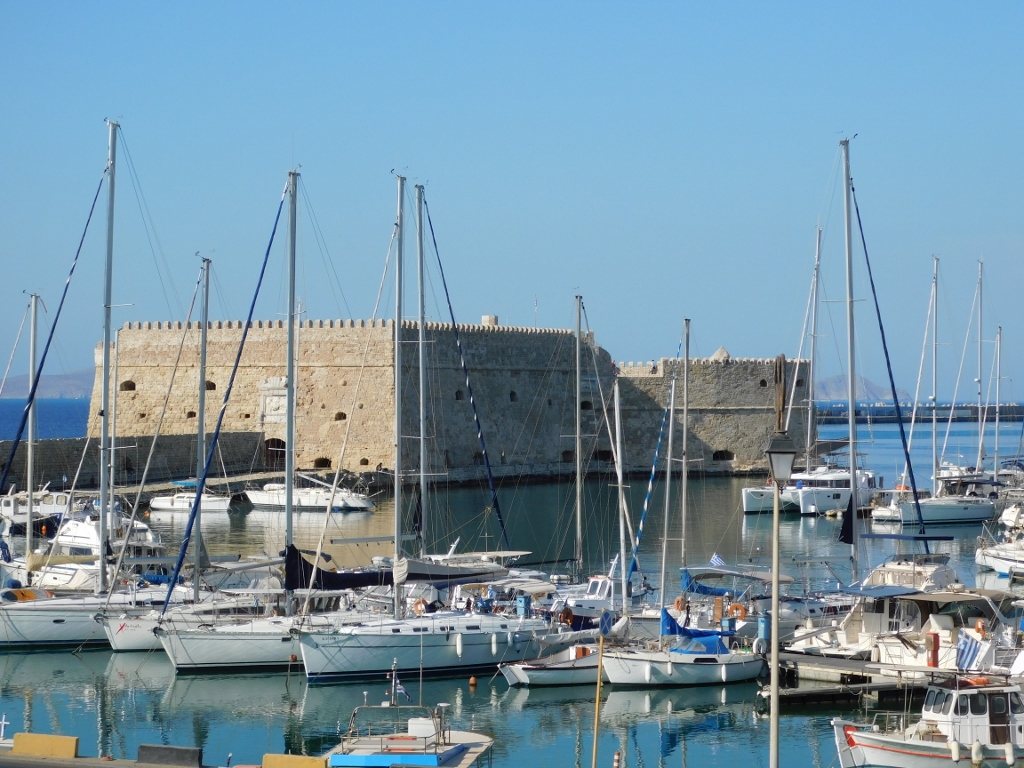 Fortress and the old (Venetian) port in Heraklion
Fortress and the old (Venetian) port in Heraklion
Still, my decision was to walk to the fortress only a little later and for the time being I headed for the selected café. Along the way I walked past the remains of the Venetian Arsenal. This was the place where in fact there used to be a spacious Venetian shipyard. Since all of Crete and Candia in particular carried a lot of importance for Venice on account of the trade with Egypt, Syria, Cyprus and numerous islands of the east Mediterranean, the present-day Heraklion became in a way “Venice of the East” and thus around 50 galleys could anchor at the port. This also required a shipyard (during their reign, the Venetians built 19 shipyards) in which the ships were not only built, but also repaired and stored during winter.
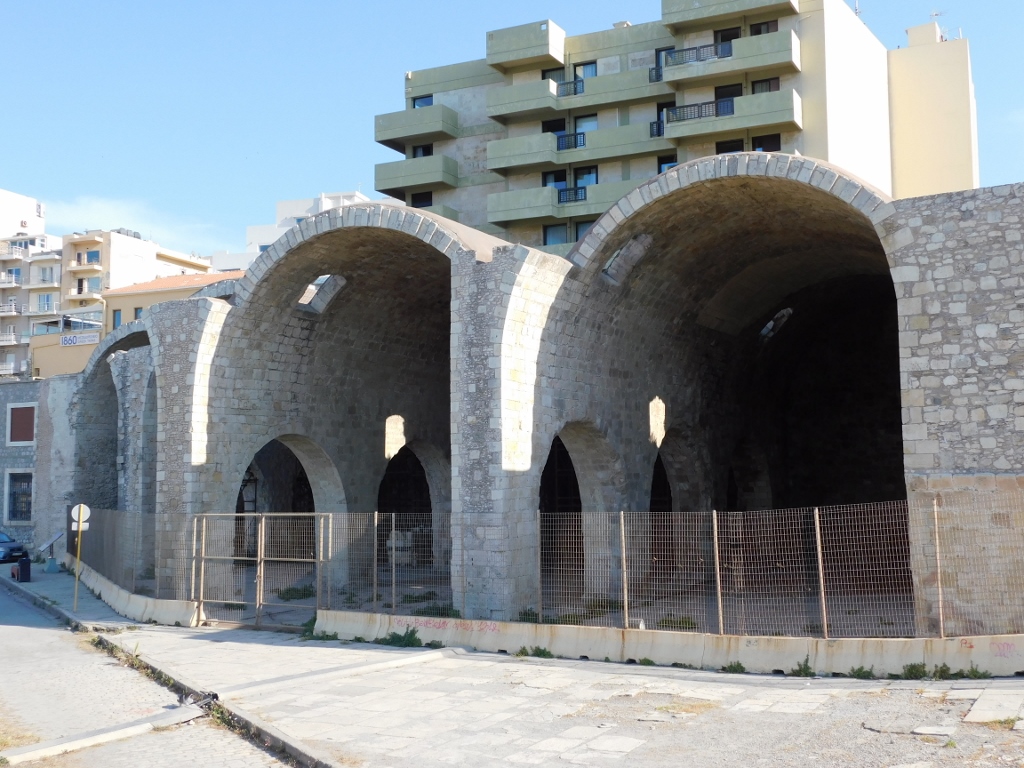 Remains of the Venetian Arsenal
Remains of the Venetian Arsenal
And after the coffee that felt quite good, I set off towards the fortress. The sights were very pretty.
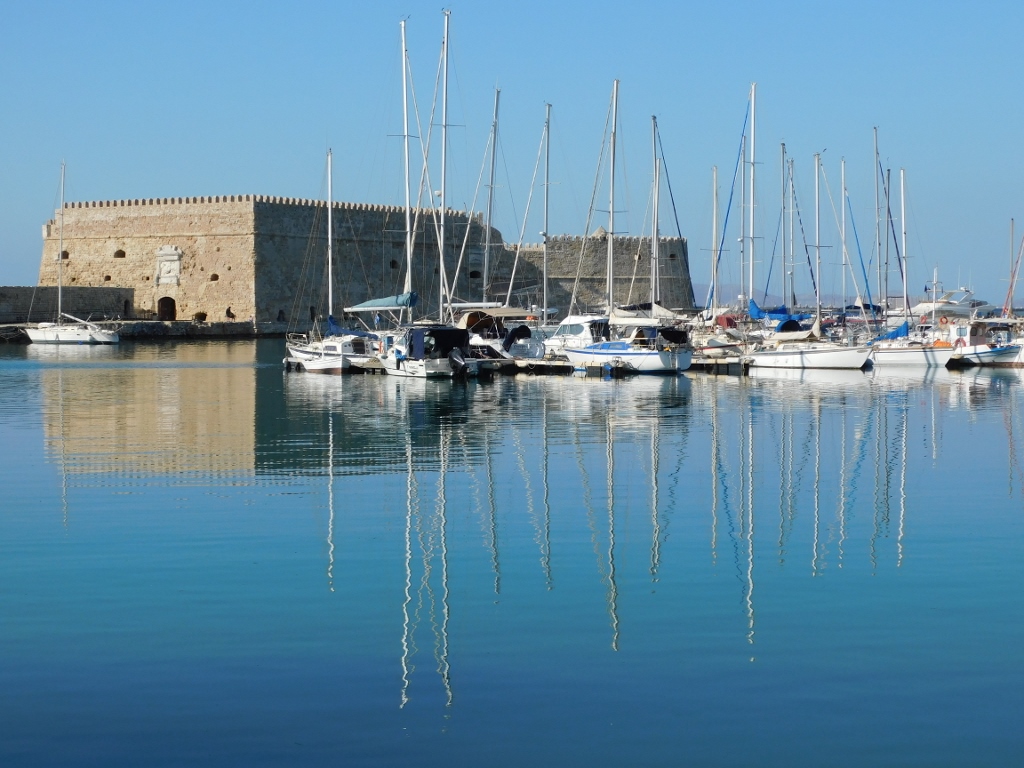 Fortress and the old (Venetian) port in Heraklion
Fortress and the old (Venetian) port in Heraklion
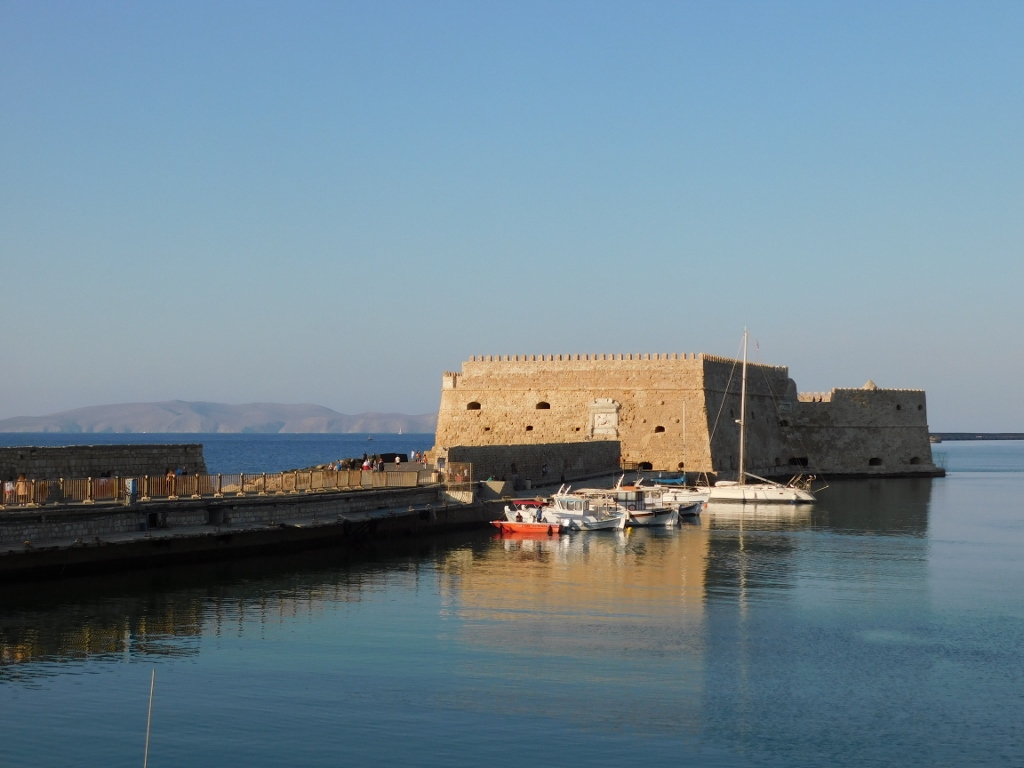 Fortress and the old (Venetian) port in Heraklion
Fortress and the old (Venetian) port in Heraklion
 Fortress and the old (Venetian) port in Heraklion
Fortress and the old (Venetian) port in Heraklion
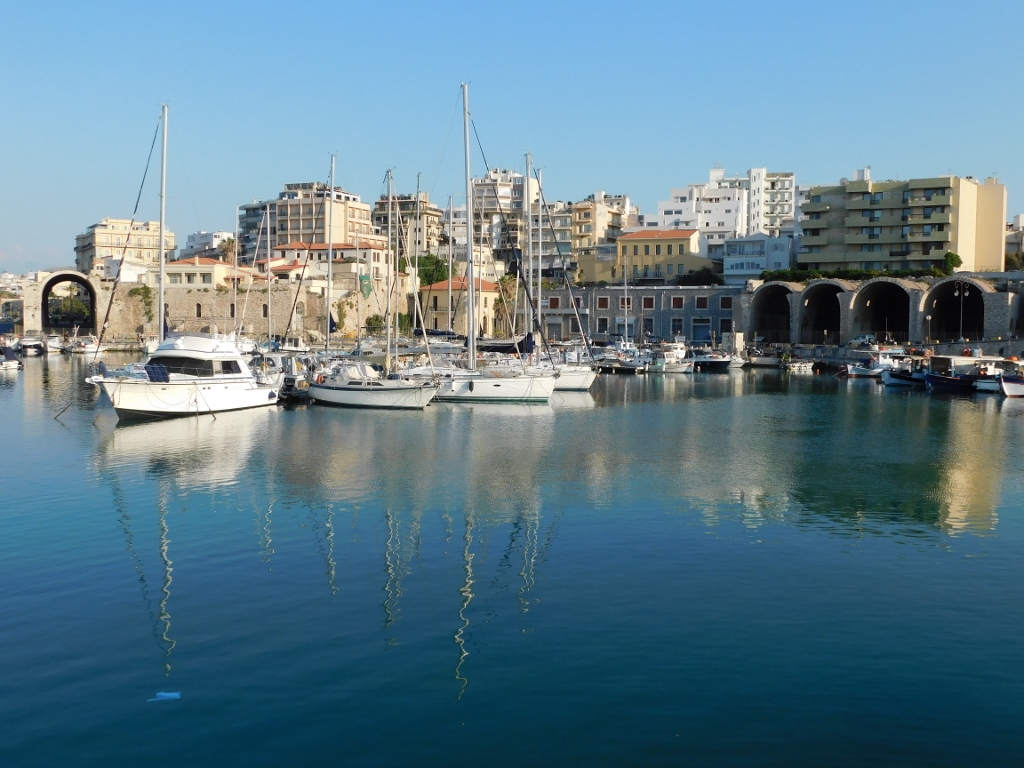 Old (Venetian) port and parts of the Arsenal in Heraklion
Old (Venetian) port and parts of the Arsenal in Heraklion
Soon I reached the breakwater where there is a wide promenade and there I headed for the fortress.
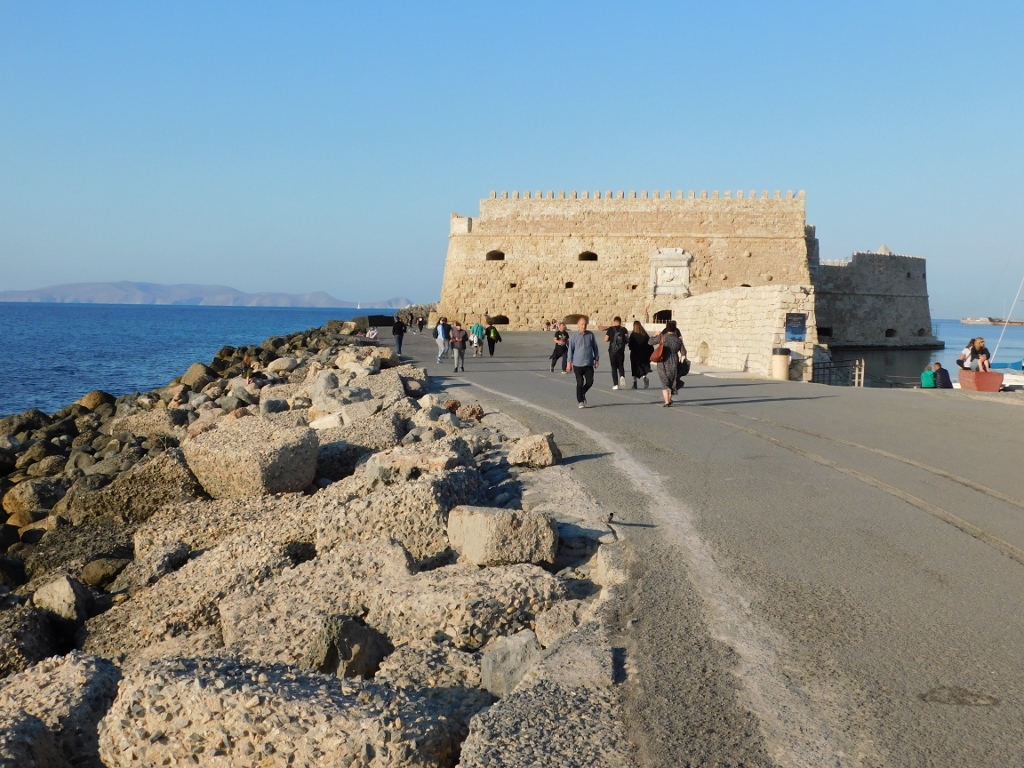 Fortress in Heraklion
Fortress in Heraklion
Several names are used for the fortress. One of them is Koules that originates in Turkish, while the other is Rocca a Mare coming from Italian, although the term Venetian Fortress is also used. The fortress got its final shape in 1523-1540, in other words during the reign of the Venetians, making the last name quite logical. Earlier it was placed at the very entrance into the port, but over time an extension of the breakwater was built which nowadays protects the large, new port, placing the fortress sort of “in the middle” of the breakwater. By the way, from the fortress to the end where Heraklion Lighthouse is located, that breakwater is around 2 km long! So, if somebody wants to, it is possible to walk one’s heart out here, while the fortress itself is only some 300 metres away from the streets of the town, so it can be reached easily and quickly.
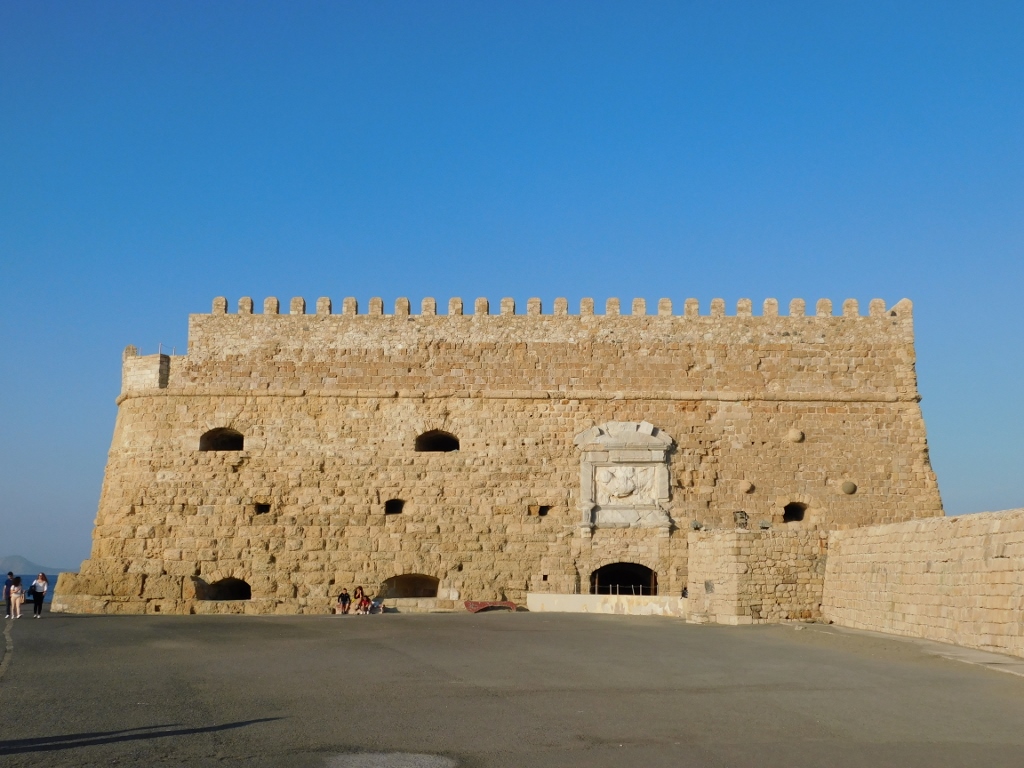 Venetian Fortress
Venetian Fortress
It is possible to visit the fortress, but I must admit I was not interested in dealing with a medieval fortress, so I just walked past it. Still, I found it interesting to see that it is still adorned by the Lion of St. Mark, the symbol of Venice and earlier of the Venetian Republic.
Moreover, the Lion of St. Mark may be seen both on the front side as one approaches and on the back, and the one on the north (back) side of the fortress is even significantly better preserved.
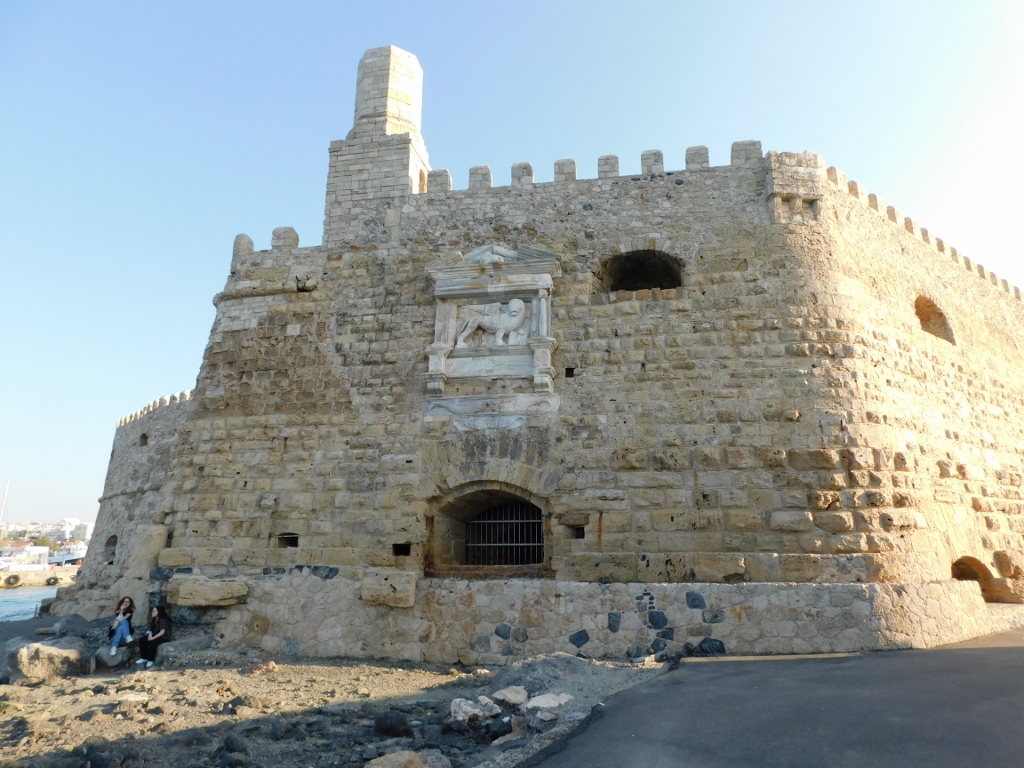 Venetian Fortress
Venetian Fortress
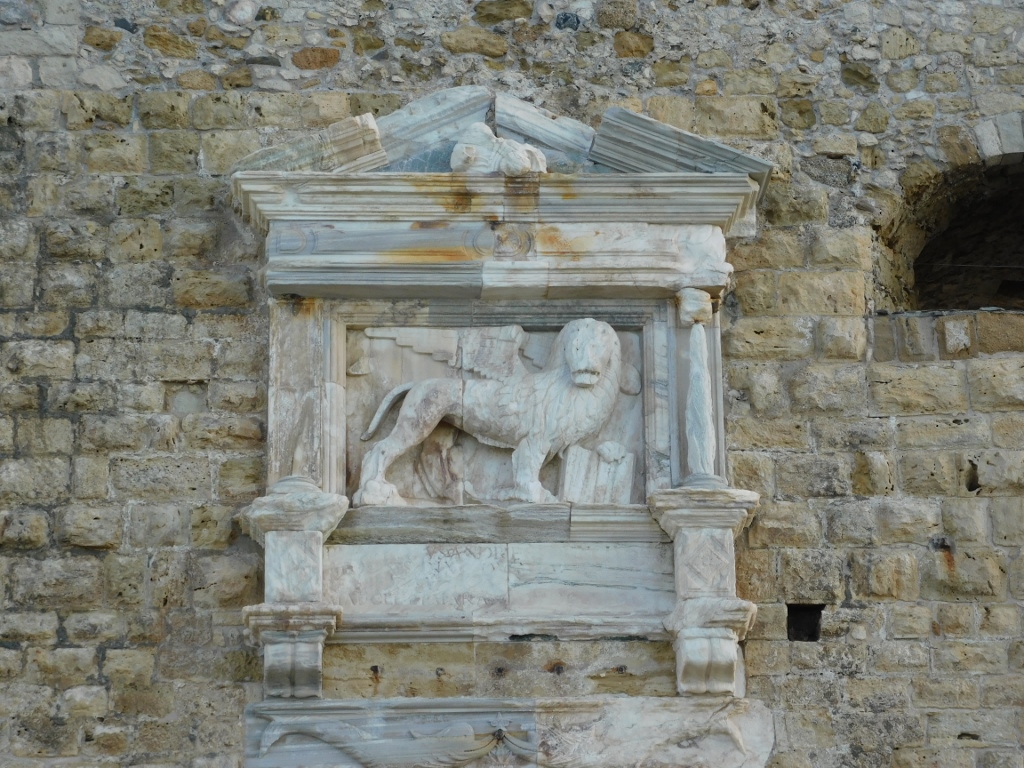 Venetian Fortress, a detail
Venetian Fortress, a detail
I walked a little along the breakwater, but not for too long, after which I returned to the town.
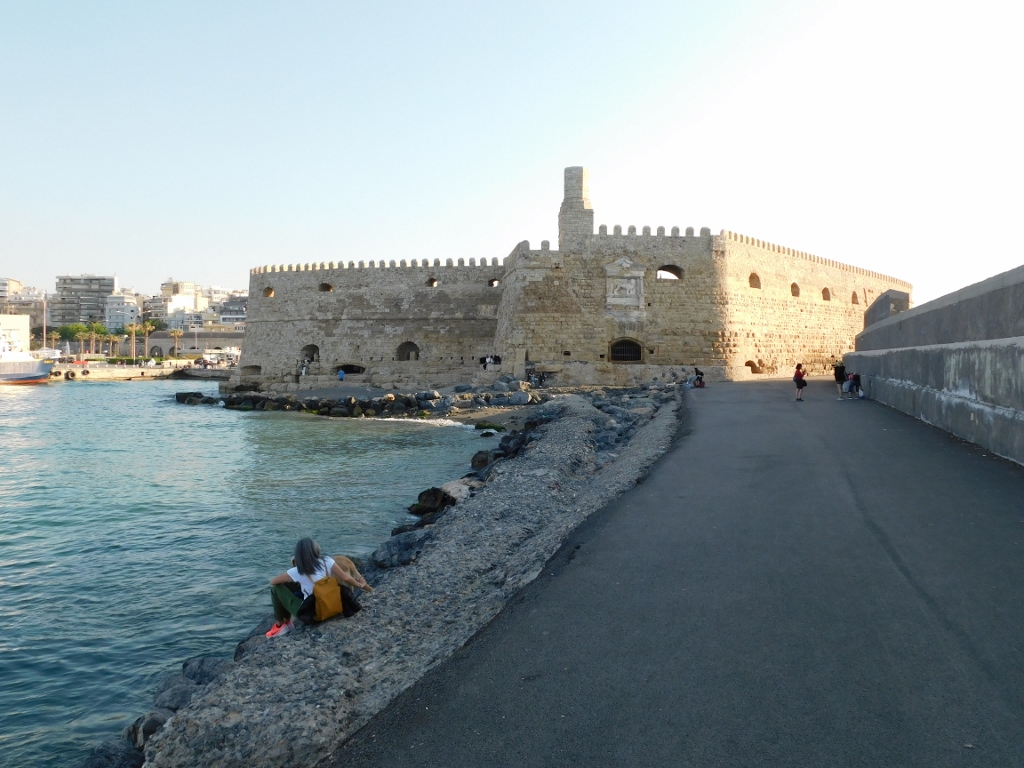 Walking path along the breakwater and the Venetian Fortress
Walking path along the breakwater and the Venetian Fortress
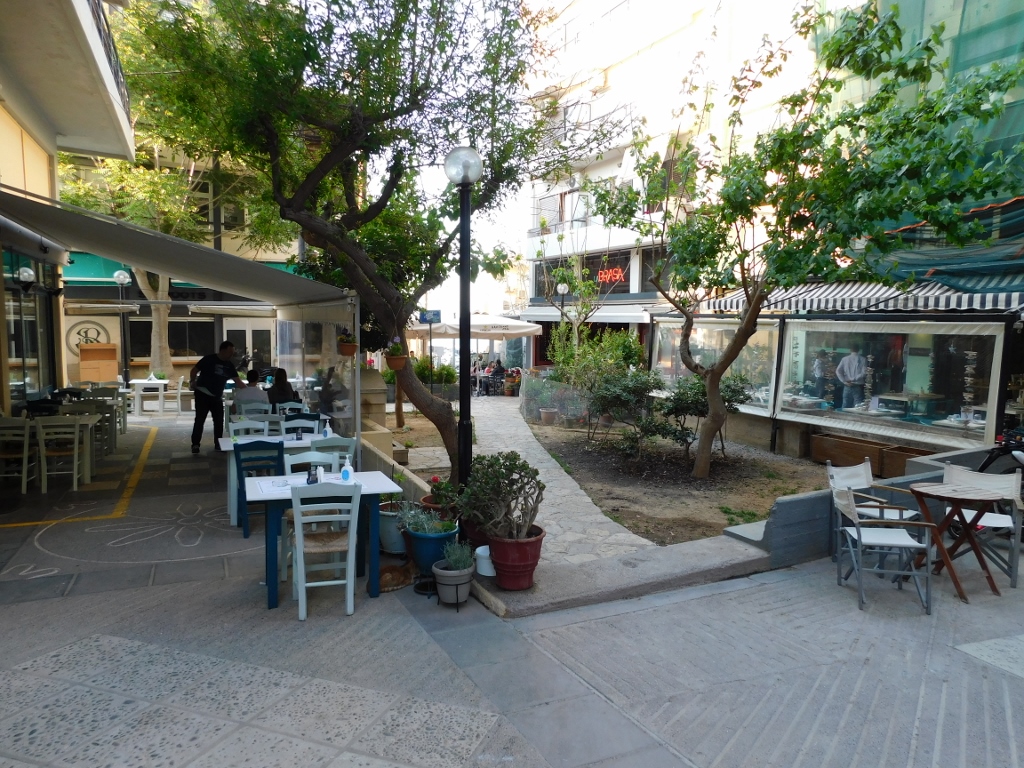 One of the numerous squares filled with cafés and restaurants
One of the numerous squares filled with cafés and restaurants
Now I walked again into the central parts of the old town in Heraklion, going left and right along different streets. Heraklion is an architectural mixture – there are contemporary business and residential buildings, there are smaller private houses, but there are also beautiful big buildings that are reminiscent of some historical times.
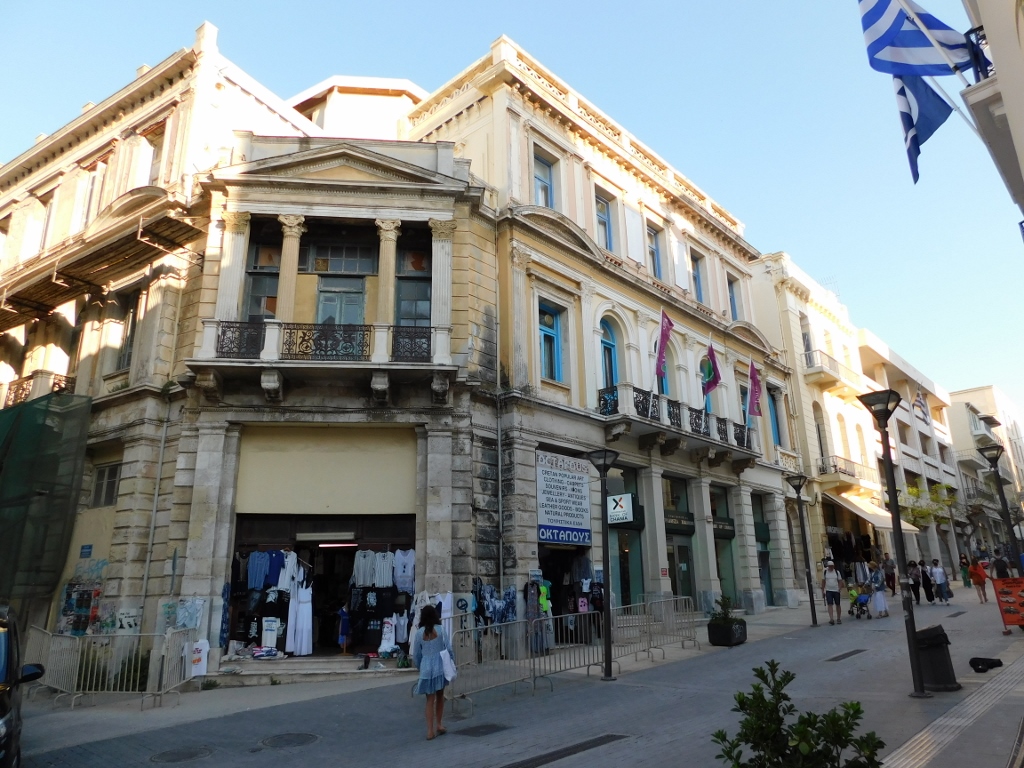 Heraklion, a detail
Heraklion, a detail
It was getting close to the sunset and I reached the Orthodox Church of St. Titus.
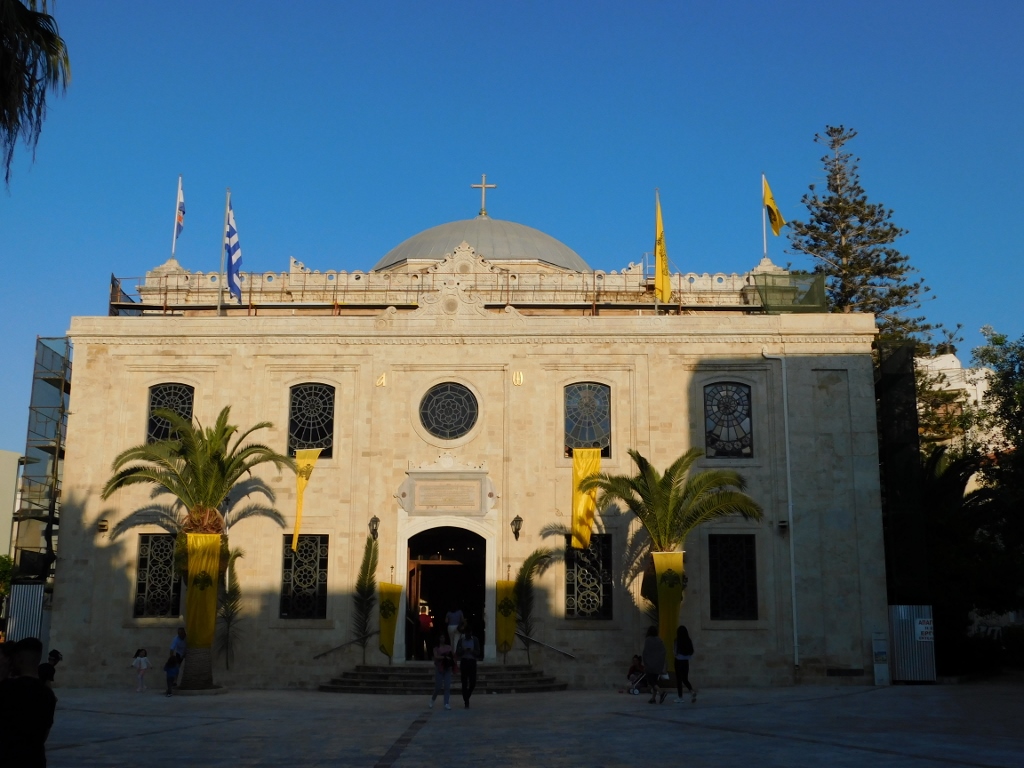 Church of St. Titus
Church of St. Titus
The first church in this place was built already in the 10th century, but then different events took place, including modifications, additions, complete destruction, a new church, damages in an earthquake and finally damage by fire. The church was built again and with the arrival of the Ottomans it was turned into a mosque only to be destroyed in an earthquake around the middle of the 19th century. The structure that can be seen here now was built in 1869, during the Ottoman rule, and it served as a mosque then. But, after the liberation from the Ottomans, the mosque was turned into a church in 1925 and since 2013 it has served as the cathedral church of the archdiocese of Crete.
Having reached the church, I only peered inside a little, but I did not want to do any sightseeing since the service was going on and I did not want to disturb anybody.
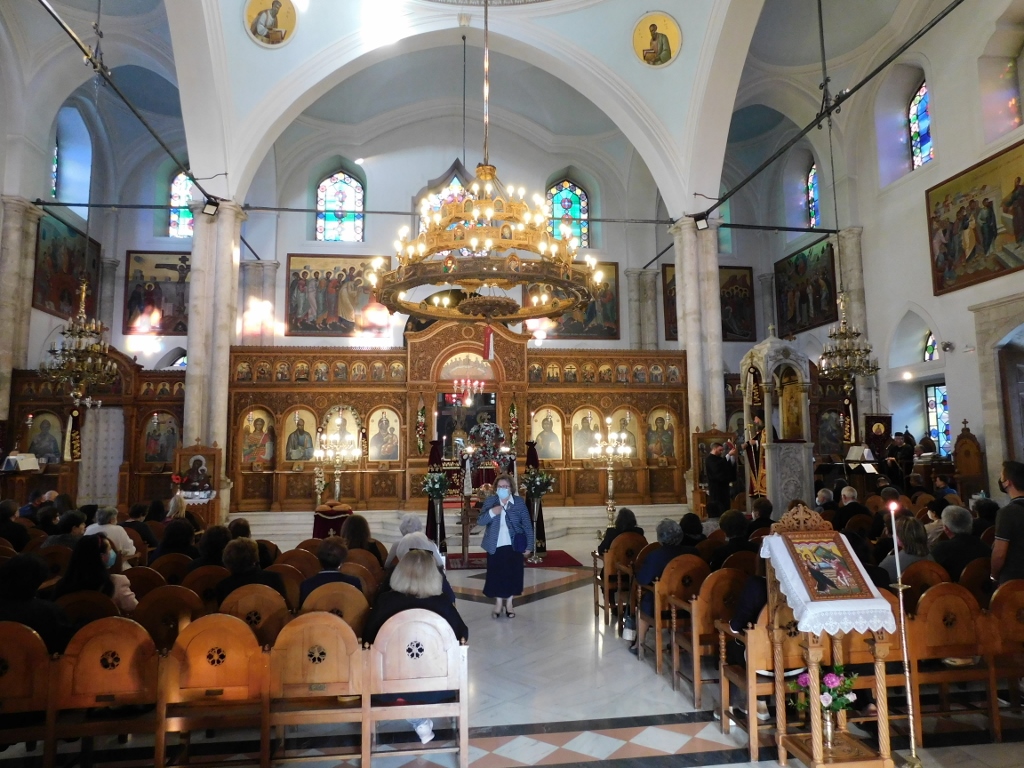 Church of St. Titus, a detail
Church of St. Titus, a detail
Then I walked around the centre a little and returned briefly to the rented flat in order to put on some more clothes for the potentially chilly evening.
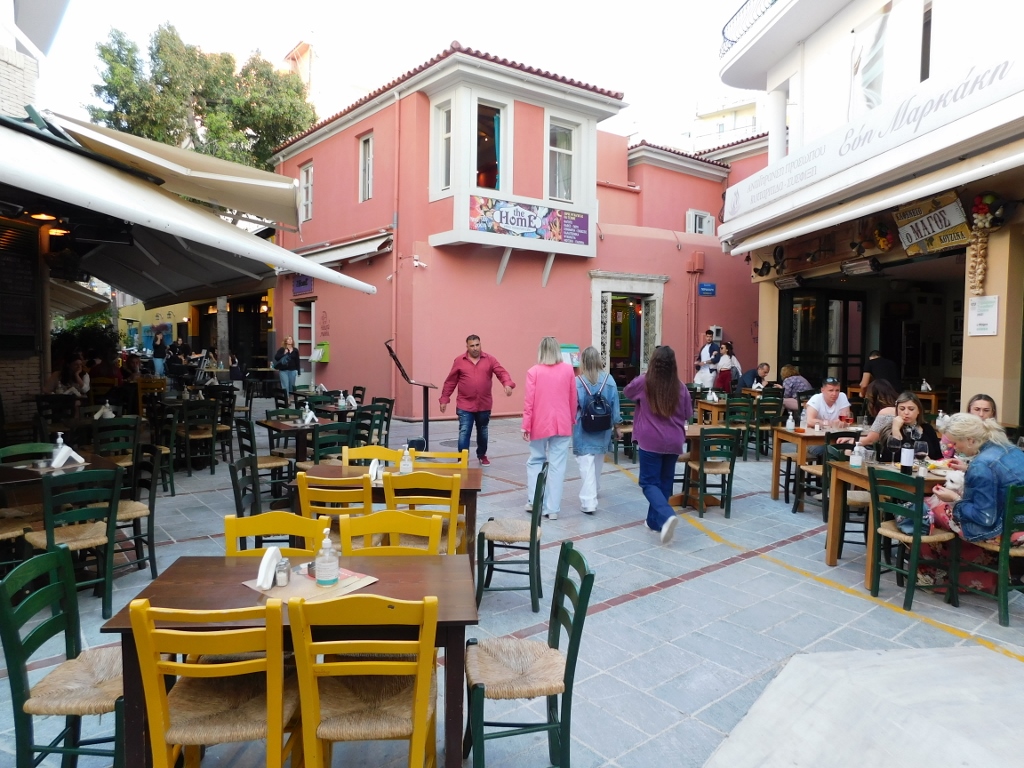 Heraklion, a detail
Heraklion, a detail
It was an early evening when I went out again, walked around the centre and sat down to have dinner.
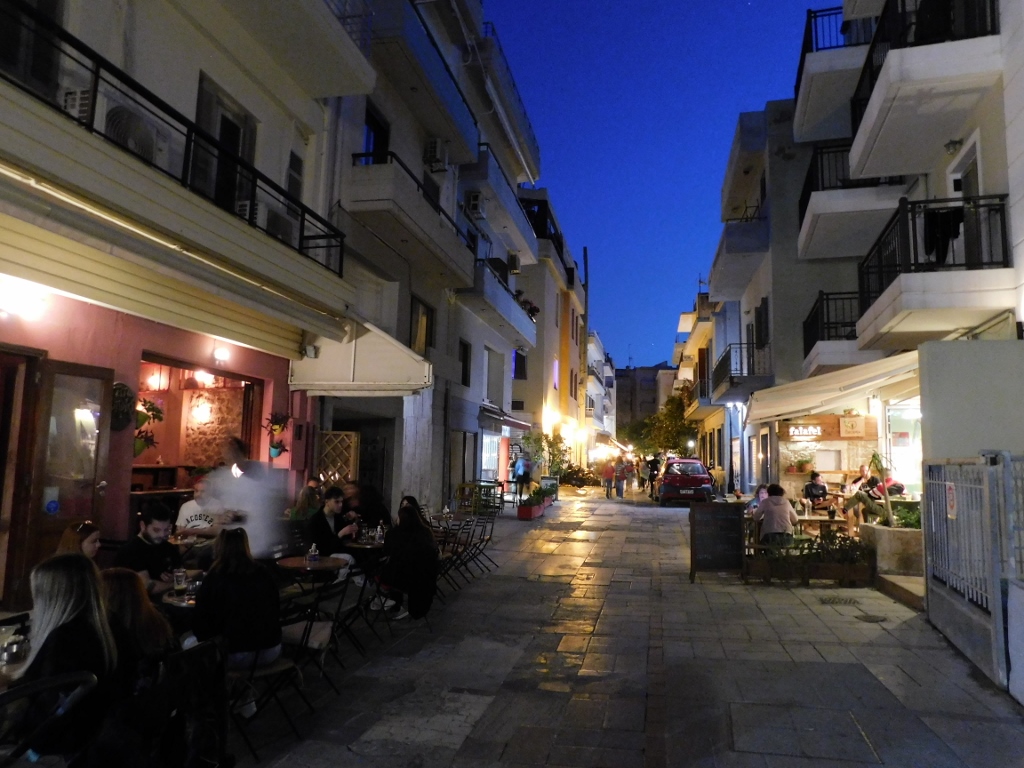 Heraklion in the evening, a detail
Heraklion in the evening, a detail
Although there was beer and the food was more or less traditional, I was not really content. It seemed to me that this was not my day as far as the food was concerned – I was simply not satisfied with any of my choices. Perhaps I just had to get used to the new destination and new taste.
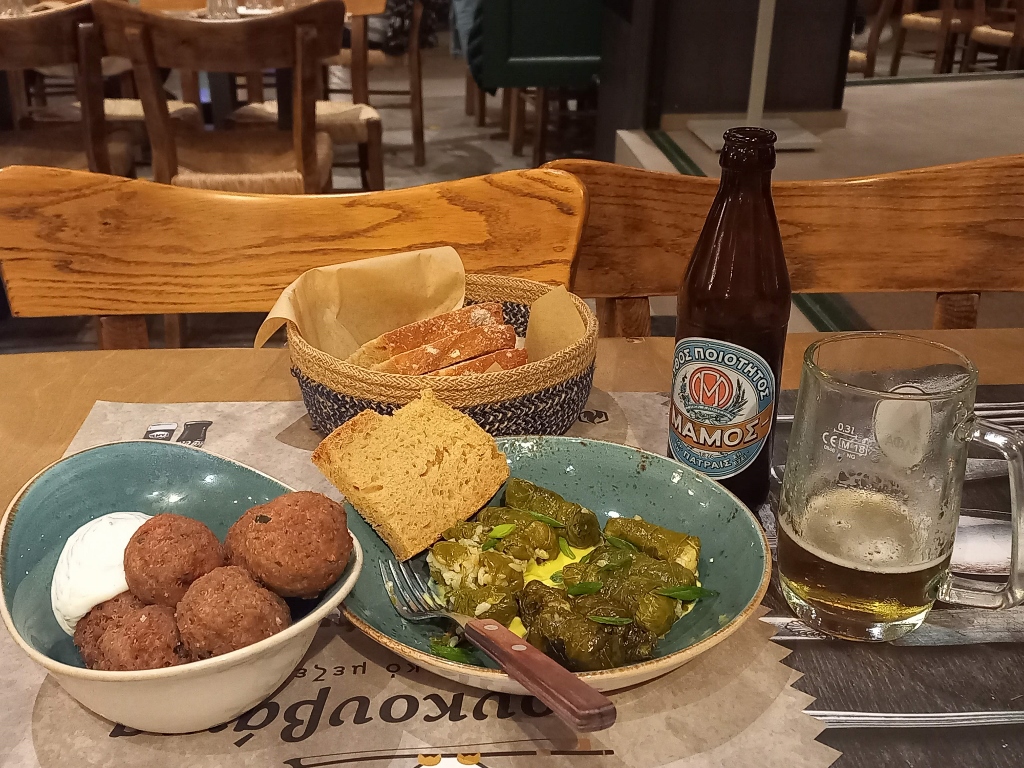 Dinner in Heraklion
Dinner in Heraklion
I did not stay here for too long and relatively early retired in order to go to bed. I had not slept enough and well the night before, so it certainly felt good to go to sleep early. After all, such a rhythm is usually a part of my holidays.
Since I visited the archaeological site of Knossos already on the first day and I saw most of the tourist attractions of Heraklion, the following morning I thought for a moment that I may get bored. This was my inner person speaking, the one who back at home always has something to do and who finds the 24-hour day simply too short.
To start with I woke up slowly checking my e-mail and working on the organisation of my travel around the island, but also taking the morning coffee which I like and having breakfast. After that I decided to walk to a couple of places and first I headed for the seashore zigzagging along the streets of Heraklion which is almost unavoidable since the streets are mostly laid down in that way. So I reached the main walking street that connects the Lion’s Square and the seashore.
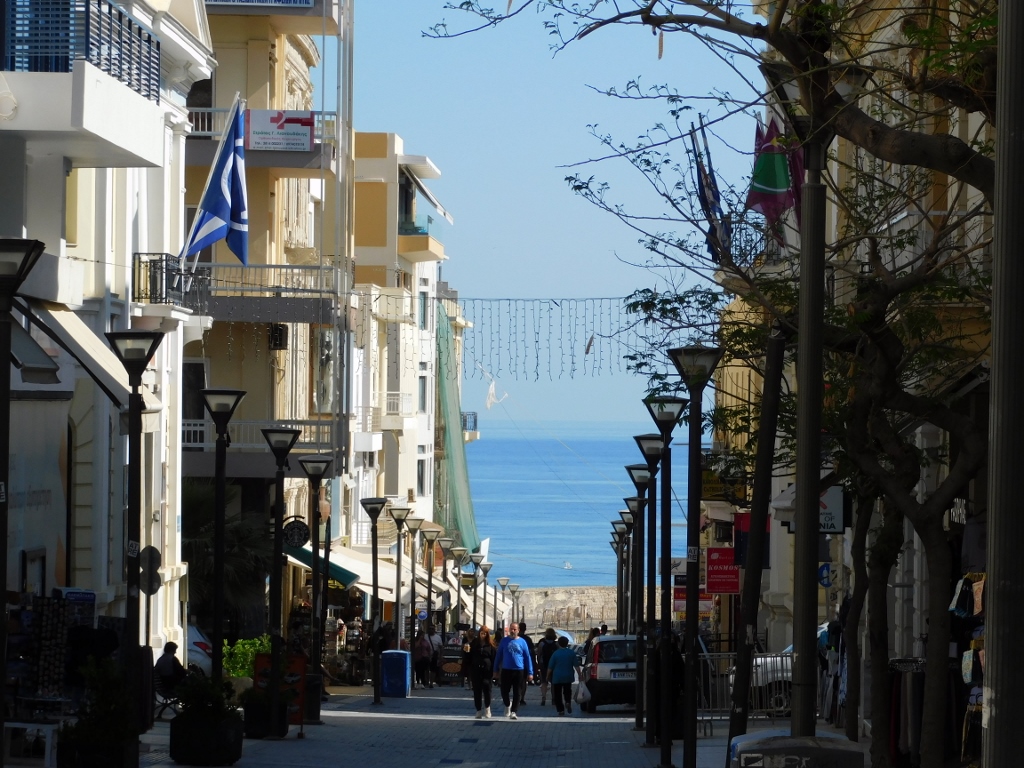 Street in Heraklion leading to the sea
Street in Heraklion leading to the sea
At this time, the sunrays fell at a different angle than the afternoon before, so I found it interesting to take photos again of the old port and the Venetian Fortress.
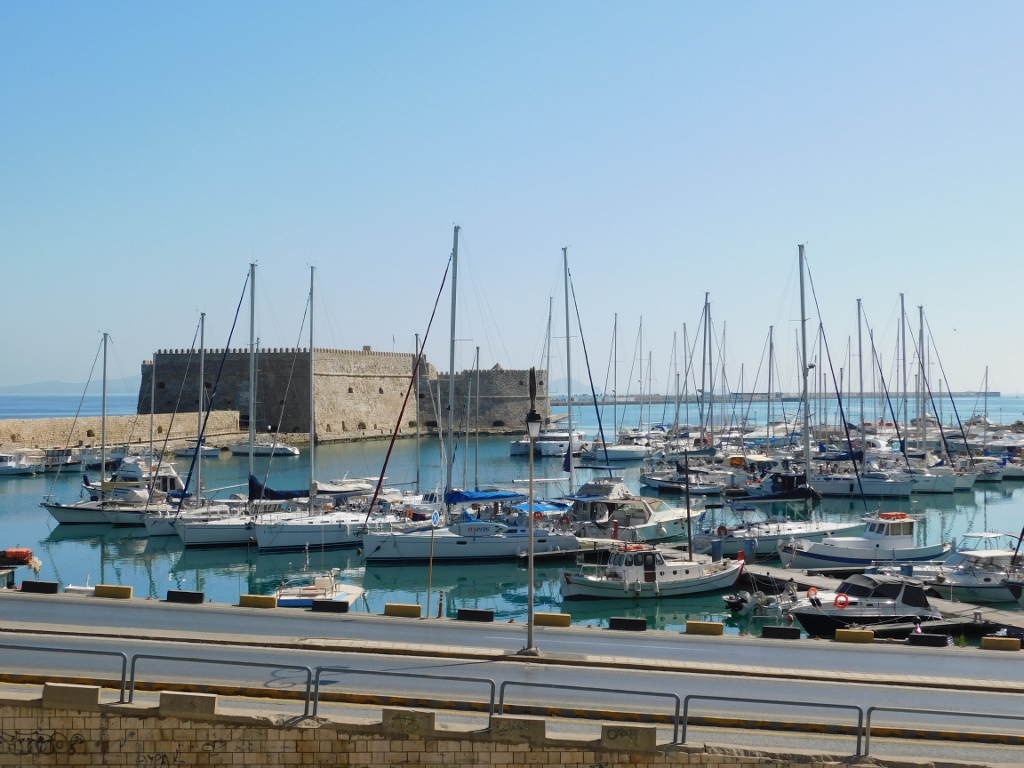 Venetian Fortress and the old port in Heraklion
Venetian Fortress and the old port in Heraklion
I got to the shore there and headed a little to the other side looking at the sights around me.
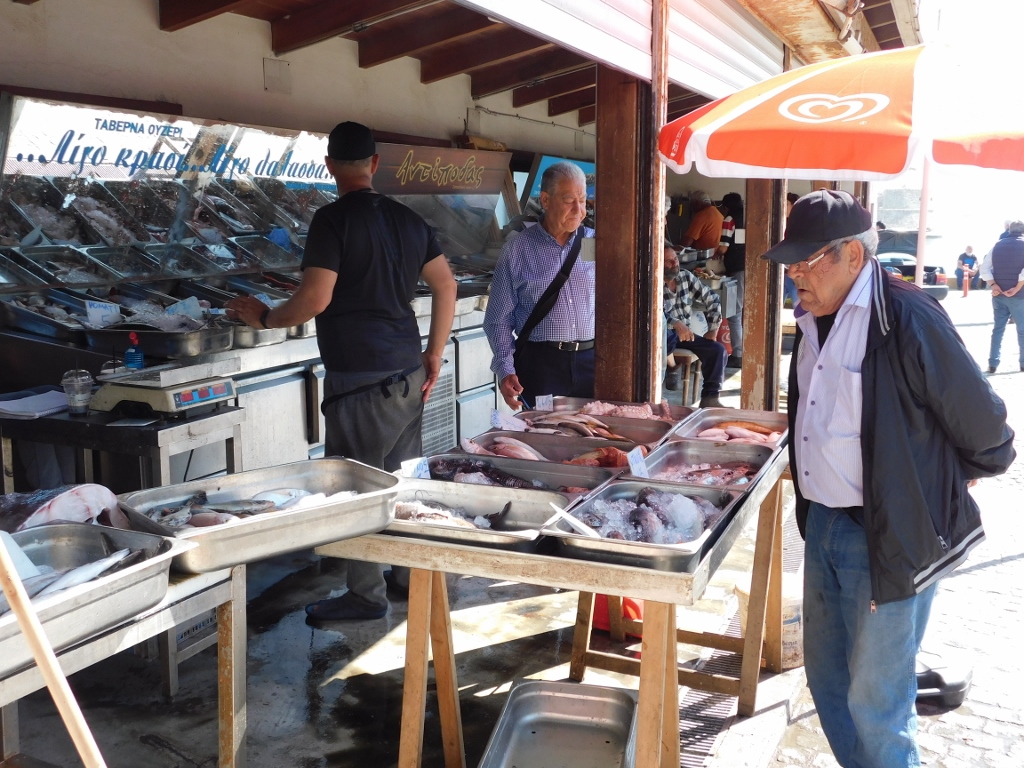 Fresh catch on sale
Fresh catch on sale
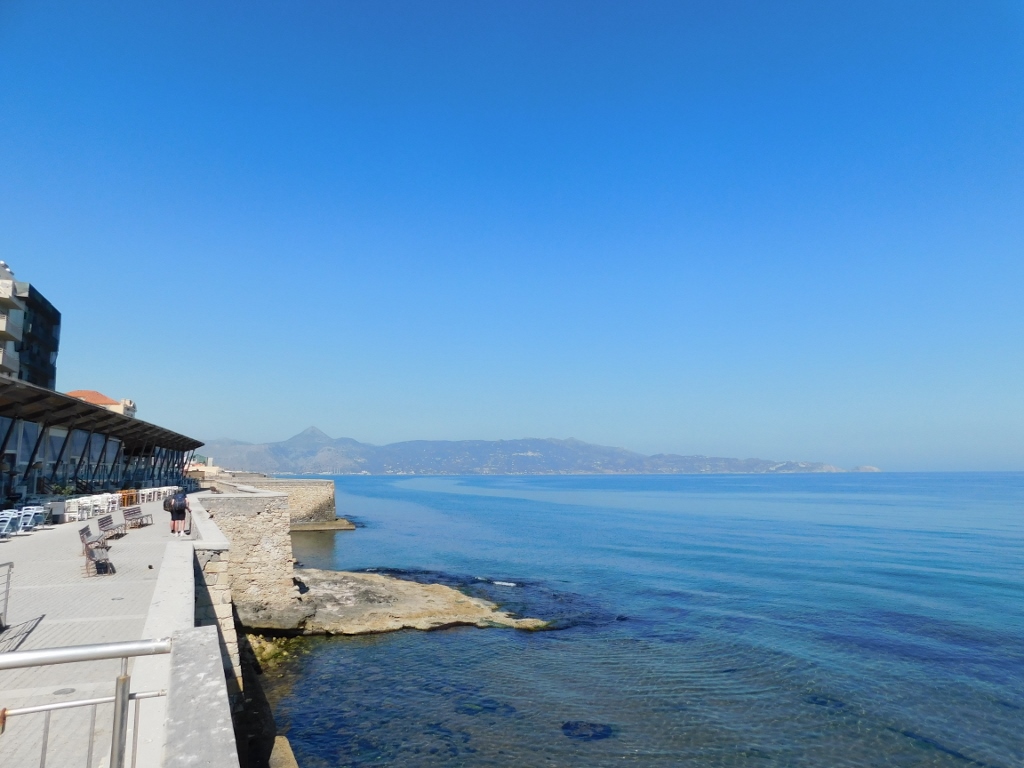 View at the areas west of Heraklion
View at the areas west of Heraklion
I stayed close to the sea for a short while and then started to return to the very core of the old town. Like the previous day, I walked again by the small Church of Saint Demetrius.
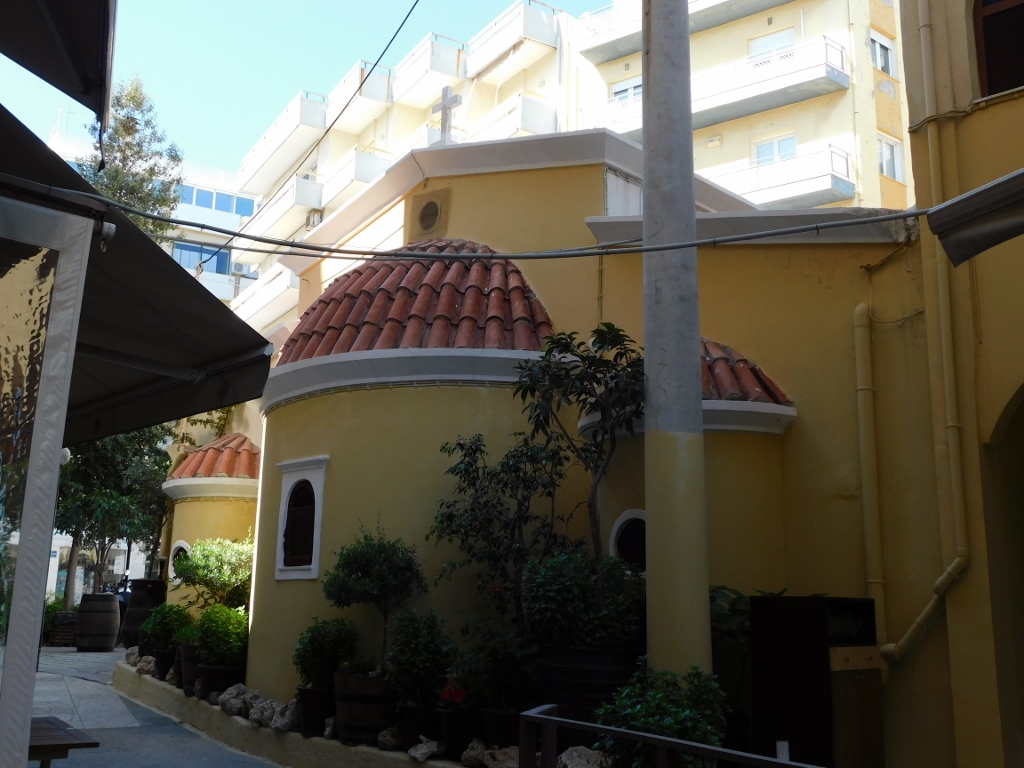 Passage leading beside the Church of Saint Demetrius
Passage leading beside the Church of Saint Demetrius
If you want to visit churches, Sunday morning is the ideal time. They are open then. It seemed that the service at the Church of St. Demetrius had already finished which suited me perfectly lest I would disturb anybody. I found the architecture of the church interesting, primarily its ground plan. The church is entered from the side and then one walks along a wide hallway from which there are flanking arched passages leading into the naos.
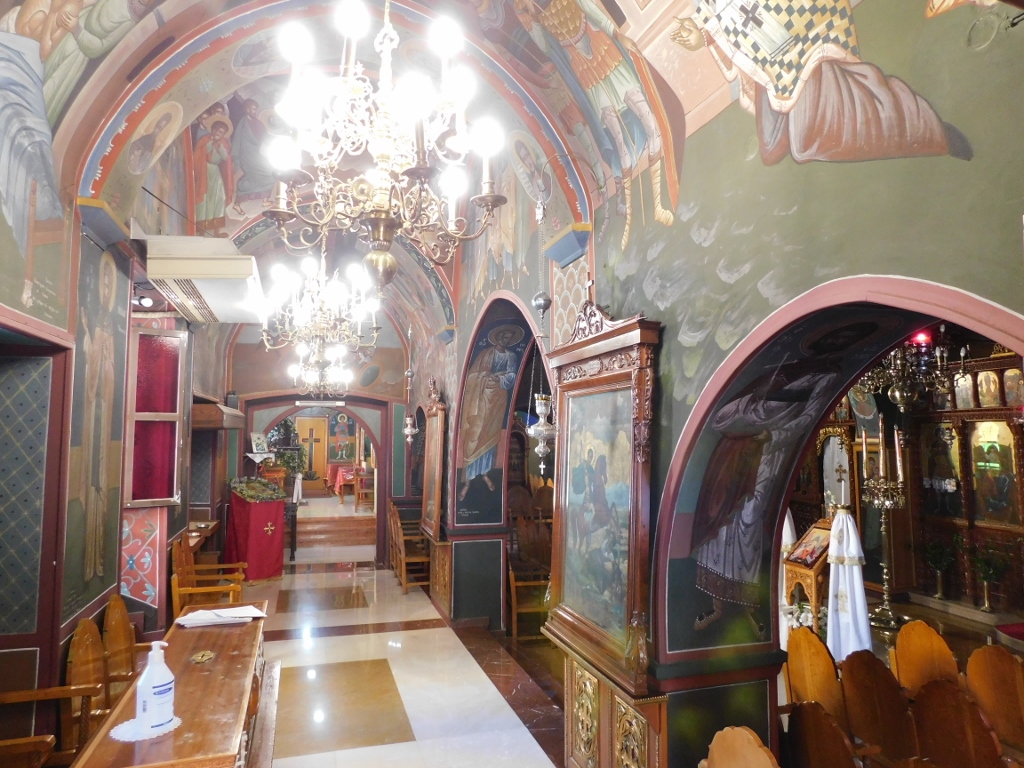 Church of Saint Demetrius, the interior
Church of Saint Demetrius, the interior
The church was first mentioned in the 16th century and then it simply followed the history of Crete and Heraklion, with a note that the Ottomans did not touch it since it was far too small. Its full restoration was completed in 1964.
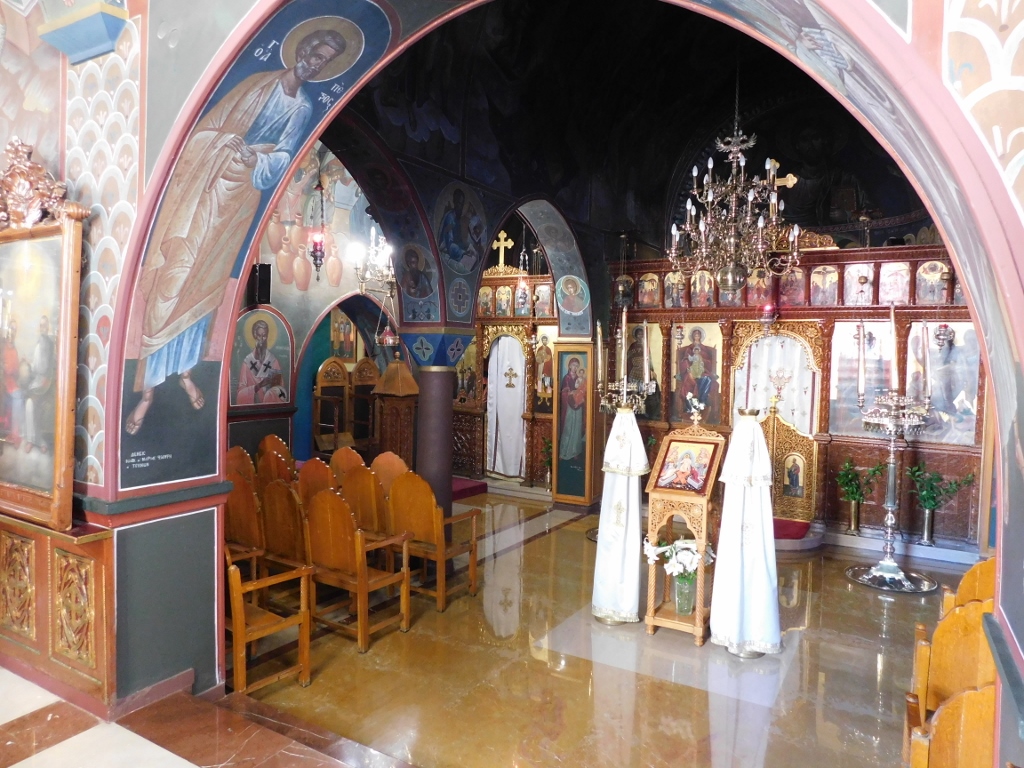 Church of Saint Demetrius, the interior
Church of Saint Demetrius, the interior
After the visit to the church, I went to the main walking street and followed it in the direction of the Lion’s Square. I have already mentioned before that one can see different beautiful buildings here.
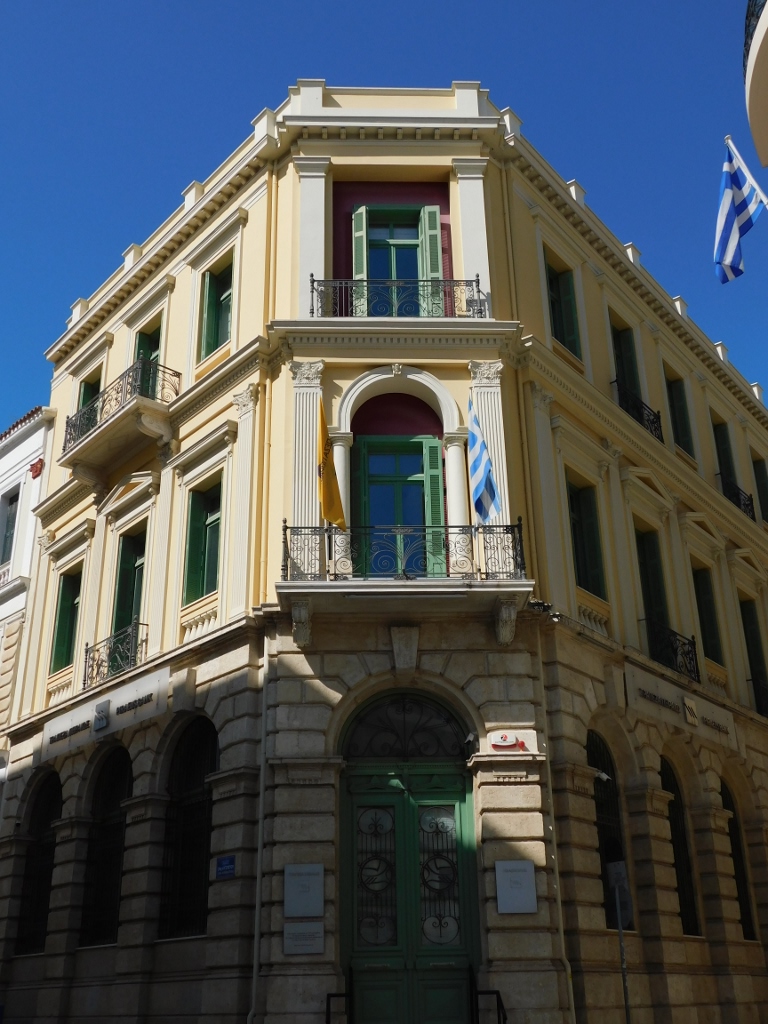 Heraklion, a detail
Heraklion, a detail
Along the way I walked again past the Church of St. Titus. It was Sunday and the service was taking place. The previous late afternoon I peered a little here, but there was also an ongoing service, so I just took a couple of photos, but I did not want to do that again. That’s why now, while being in front, I recorded by my video-camera the chanting of the priests that could be heard outside as well.
Once I reached the Lion’s Square I concluded it was the time for me to sit down. Since the morning coffee was still enough, I ordered a freshly squeezed orange juice. It was important that I was sitting and relaxing. The drink was optional.
But, it would not be really me if I didn’t want to take photos of the sights that I found pretty and that created the sense of content and fulfilment, as well as that of admiration within me. For me, taking photos is a way of expressing those inner emotions.
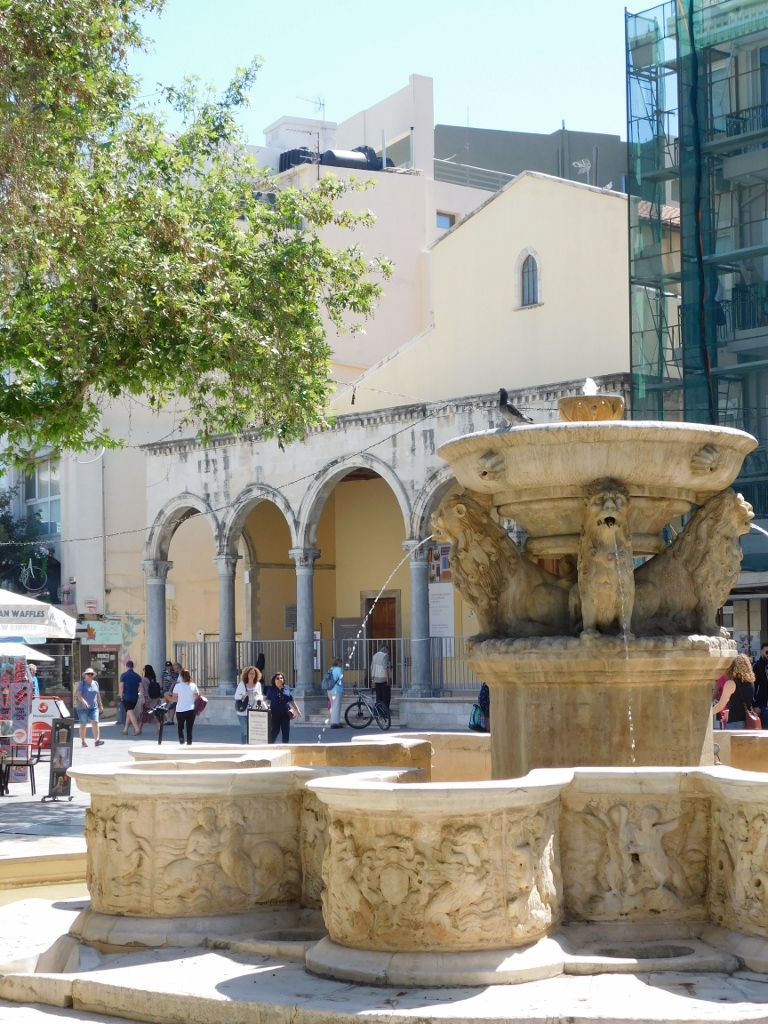 Morossini Fountain or the Lions, with the Basilica of St. Mark in the background
Morossini Fountain or the Lions, with the Basilica of St. Mark in the background
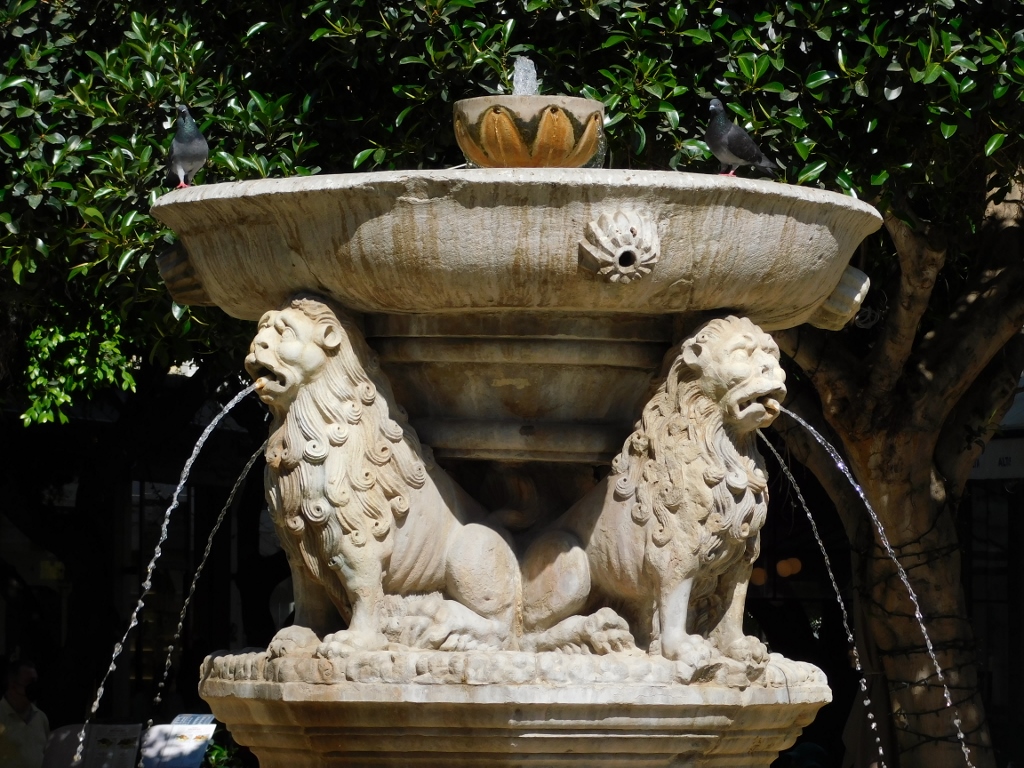 Morossini Fountain or the Lions, a detail
Morossini Fountain or the Lions, a detail
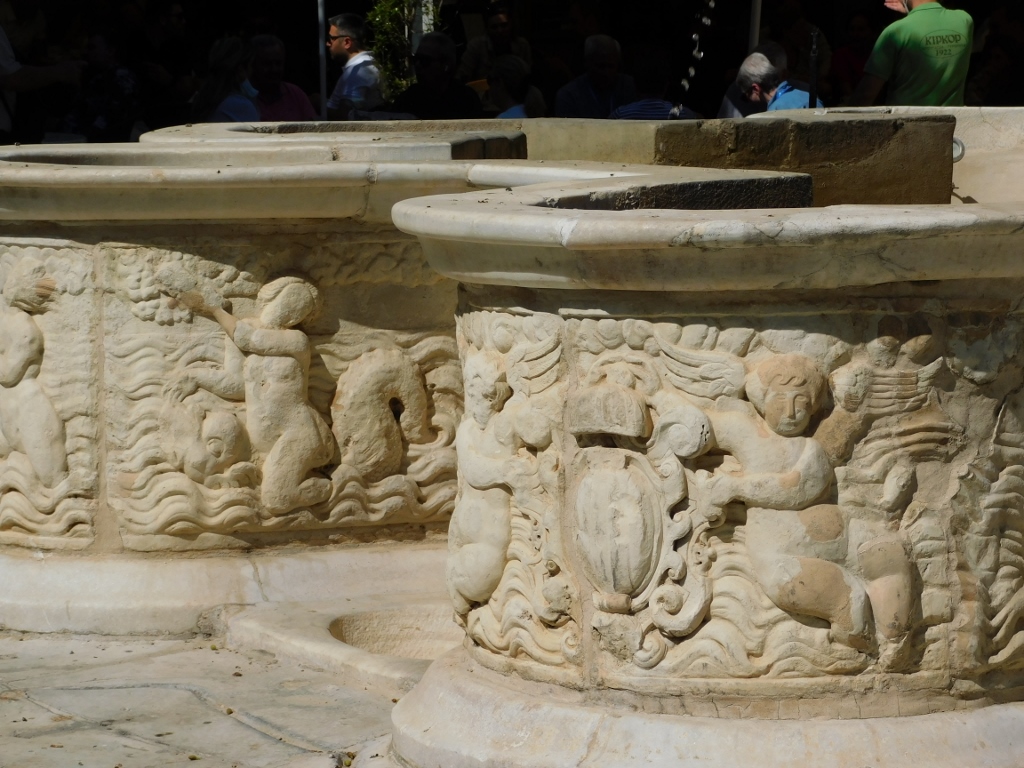 Morossini Fountain or the Lions, a detail
Morossini Fountain or the Lions, a detail
After this nice period of relaxation, I went for a walk again. I passed along 1866 street which is said to be the central market – full of fruits, vegetables, local produce, etc. Perhaps there are such goods, but not on a Sunday. Those vendors do not work then. Only the souvenir shops were open. There was Chinese goods, and Turkish goods, and souvenirs that could be bought in Turkiye as well, but there are also olives, spices, olive oil, kitchen towels, soaps, ...
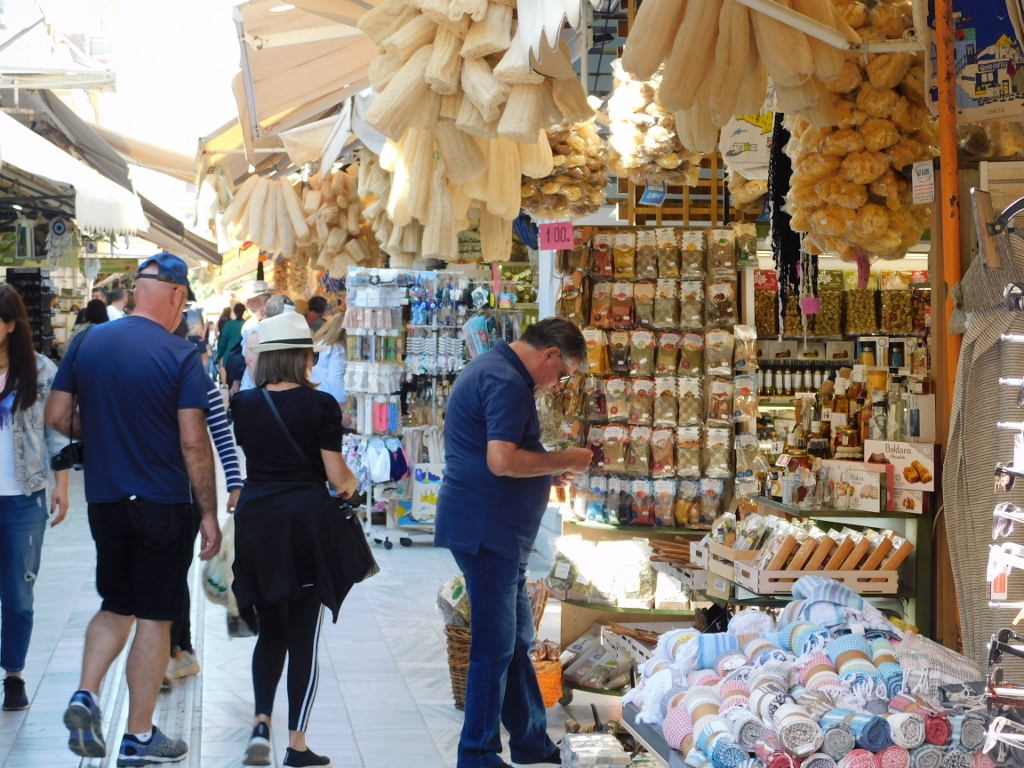 1866 street, a detail
1866 street, a detail
I went to the end of the street since there are two historical drinking fountains there, from the Ottoman and the Venetian periods. I have already written about them in the previous sequel, but they are picturesque enough for me to wish to take photos of them again.
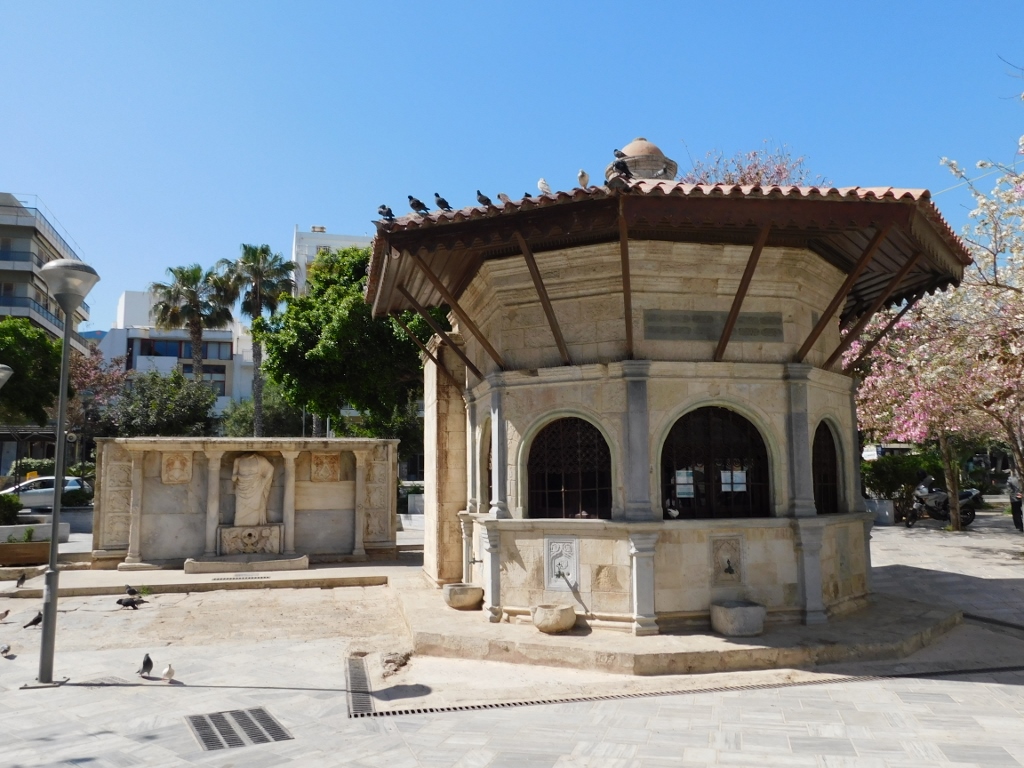 Venetian fountain (Bembo) is to the left, while the Ottoman one is to the right
Venetian fountain (Bembo) is to the left, while the Ottoman one is to the right
After this, I started with my fact-finding. Namely, the following day I was to begin with my travelling around Crete, this time using public transportation, i.e., a coach, so I first walked to the Central Intercity Bus Station in order to see where exactly it was and which would be the best and most efficient route for me the next day. As it turned out, this was a very good idea, since I first headed towards some coaches that I saw parked in a square-like place and this was actually wrong, because those were some tourist coaches. It would have been much worse if I had done this while carrying my luggage. This way, I went down to the bus station (which is close to the port) unhindered, asked about the details, got a time table and then returned to the elevation where the Heraklion Archaeological Museum is located.
Along the way, I walked past the Yenicar Aga Fountain from the Ottoman period which is located by the street that leads from a roundabout near the Heraklion Archaeological Museum down to the port and the bus station.
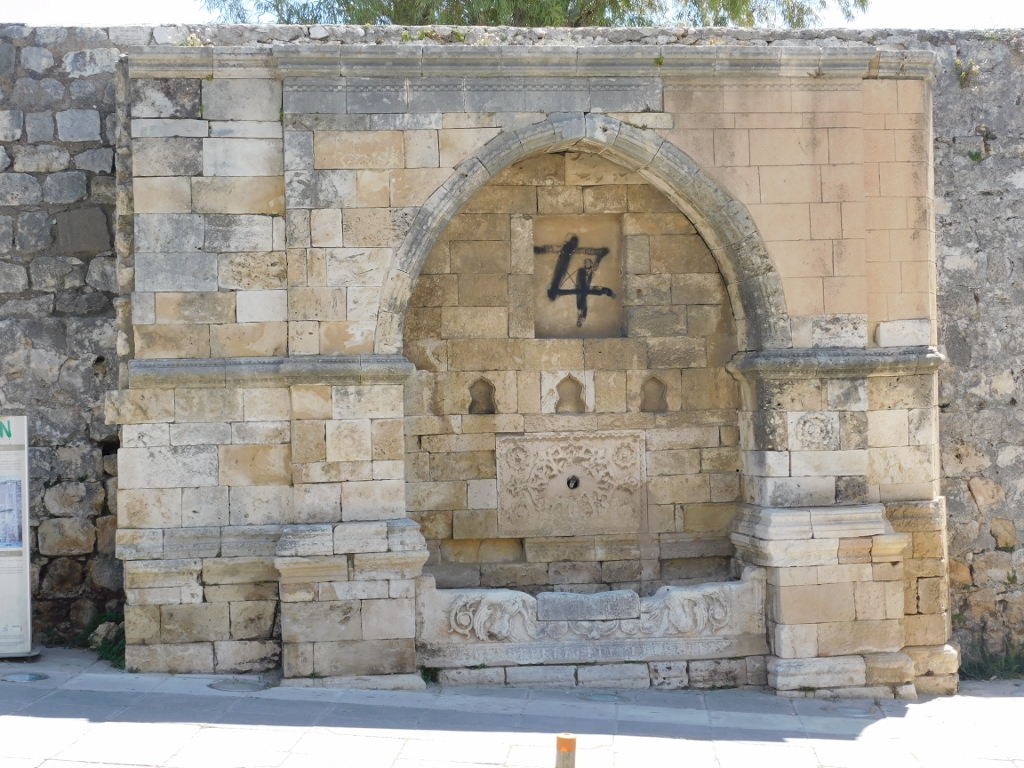 Yenicar Aga Fountain
Yenicar Aga Fountain
Namely, Candia (the present-day Heraklion) had problems with water supply in the past. During the period of the Venetian occupation, the water was obtained from wells (1270 wells) or cisterns (273 of them) that collected rainfall. The first public fountain was Bembo from the 16th century.
Because of their religion, the Ottomans perhaps had even more need for fresh water and so the rich pashas and agas (aghas) regularly built public fountains that were named after them. This fountain was originally located in the centre of the town, but the house that the fountain was a part of was demolished in 1980 and the fountain was moved to its current location.
As for my visit to the museum, when I went to Knossos the day before, where I visited the famous palace from the Minoan period, I purchased a combined ticket, so now I did not have to bother with that, although it was admittedly not crowded.
I must say right away that the Heraklion Archaeological Museum is absolutely spectacular! The Minoan culture is certainly famous and I remember that I learned about it back in the high school in history of art classes and yet, I was still greatly stunned by the impressiveness of the artefacts exhibited here. Among other things, I was especially attracted by the pottery pieces, some of which were made during the period pertaining to the Minoan civilisation (around 3500- around 1100 BCE), while some belong to the prehistoric period (around 5300-around 3500 BCE). The fact is that I have always been fond of pottery and over the last several years I have also been making my own pottery, so this was a true revelation for me and I intensively enjoyed. On the other hand, knowing the craft (without any pretensions, for I am a layperson with some experience), I was fascinated by the sublime skill of these artists living and working some 3500-7500 years ago!
And so, one of the first artefacts to catch my eye was made approximately in the period 5300-3000 BCE (it is not possible to establish the date more precisely). It shows a female figure sitting down with crossed legs, while her fleshy buttocks and prominent breasts undoubtedly symbolise fertility.
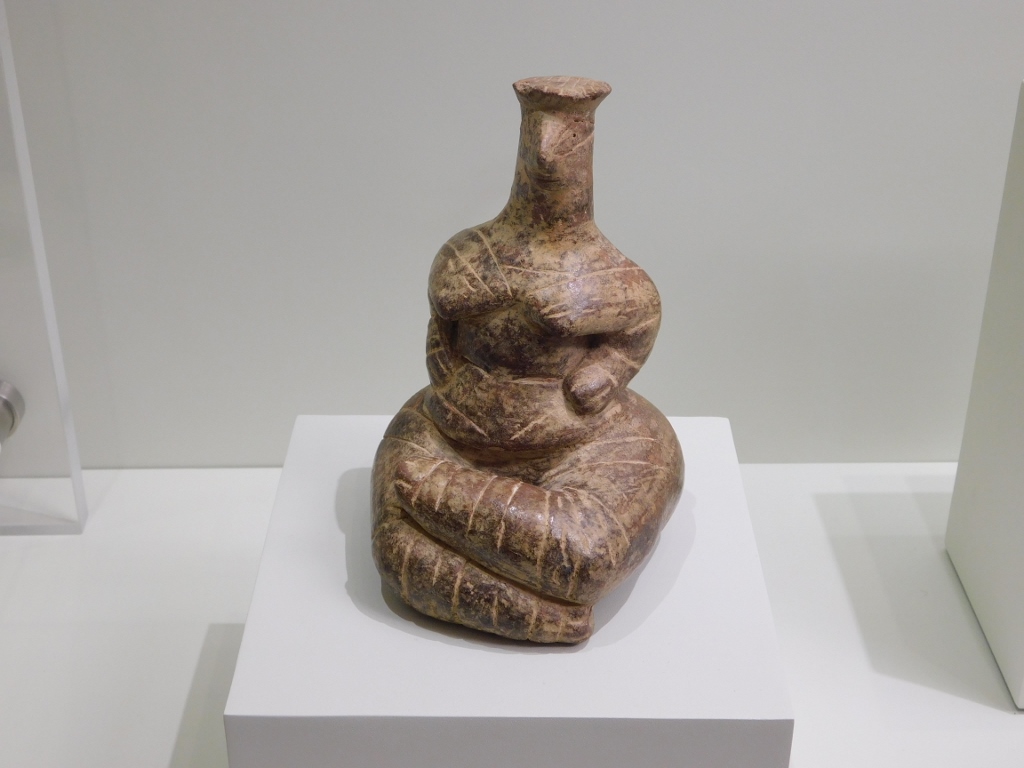 Clay figurine of a squatting woman
Clay figurine of a squatting woman
Although clay was used for the production of different figurines later as well, I always find vessels particularly interesting and impressive. Some of them used to have mundane purpose, while others were clearly used for banquet ceremonies (on account of the size which surpasses the needs related to a usual daily use).
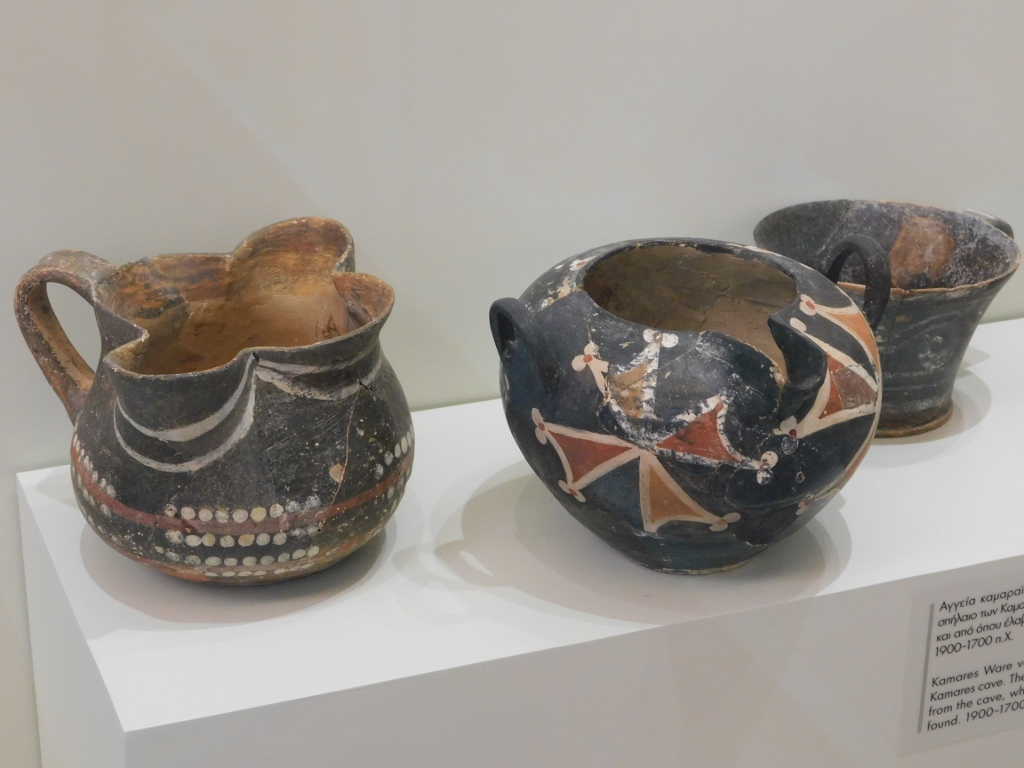 Pottery vessels from the period 1900-1700 BCE
Pottery vessels from the period 1900-1700 BCE
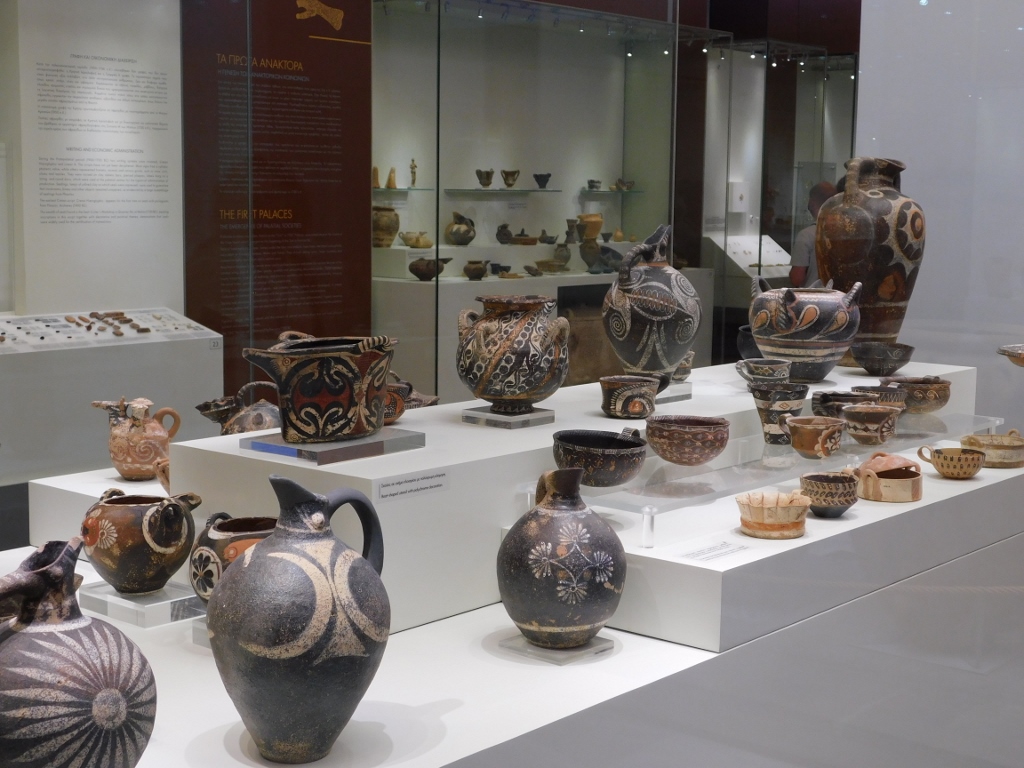 Pottery vessels from the period 1900-1700 BCE
Pottery vessels from the period 1900-1700 BCE
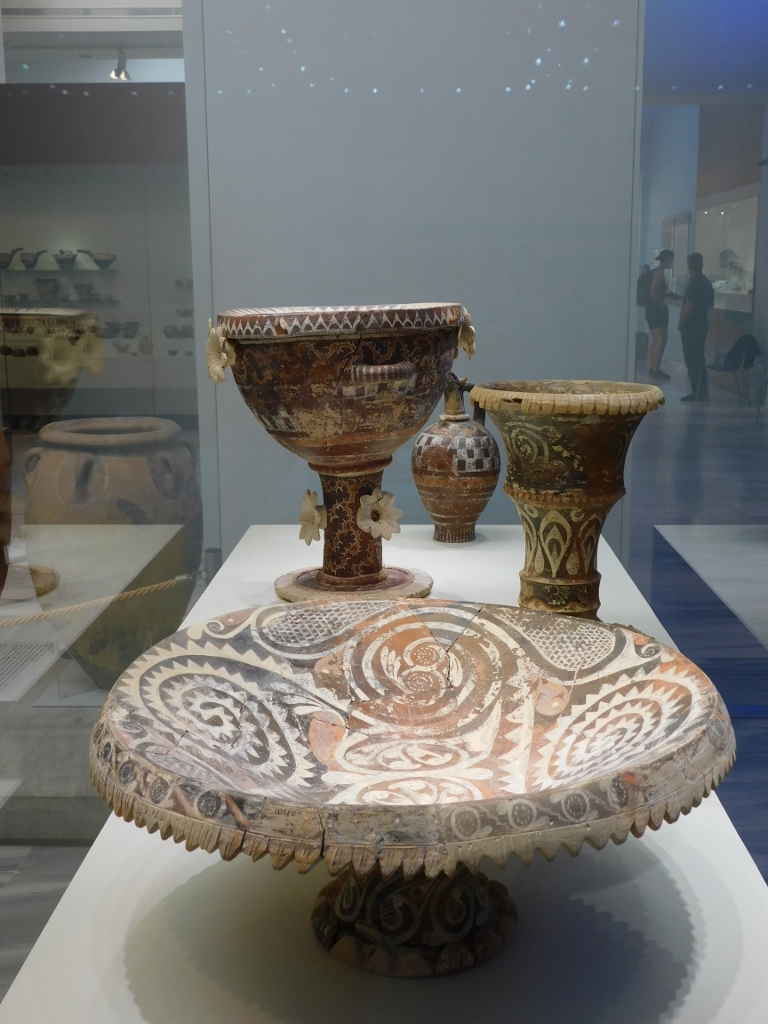 Luxury pottery vessels discovered at Phaistos from the period 1800-1700 BCE
Luxury pottery vessels discovered at Phaistos from the period 1800-1700 BCE
This is just a very small selection of what can be seen at the museum. I will write about some other interesting artefacts found at the museum in the next sequel of my travel stories.